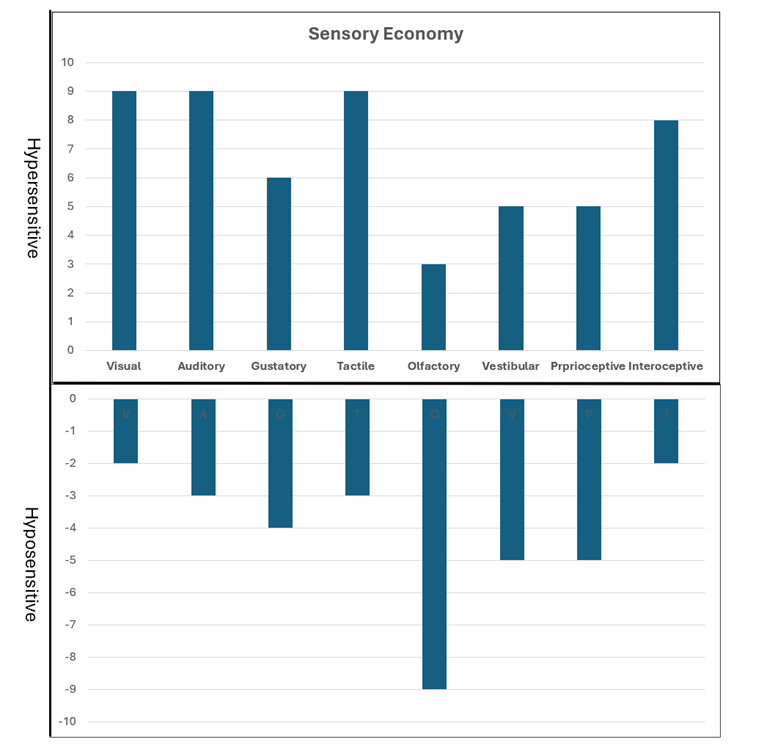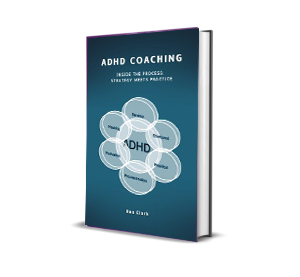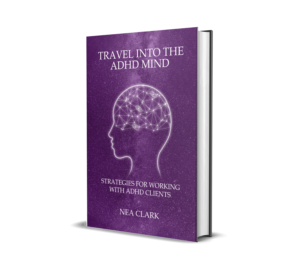Sensory Economy: Navigating Sensory Overload
For a long time, we were taught that humans have just five senses: sight, hearing, touch, smell, and taste. However, if you’ve ever worked with neurodivergent clients, you know that sensory experience is far more complex than that.
Occupational therapy and neuroscience now recognise eight sensory systems, not five. These include the lesser-known vestibular (balance), proprioception (body awareness), and interoception (internal body signals) systems. Together, these systems shape how we move through the world, how we feel, focus, react, and even regulate our emotions.
Understanding these systems is particularly important when supporting neurodivergent individuals, especially those with ADHD. Sensory overload, emotional dysregulation, and meltdowns often stem from imbalances within these sensory pathways. As professionals, the more we understand the difference between hypersensitivity (too much input) and hyposensitivity (too little), the better equipped we are to support meaningful change.
If you’re curious to explore these ideas further, my book Travel into the ADHD Mind offers an in-depth look at the sensory world of ADHD and how to create balance within it. You’ll find strategies, case insights, and tools to better support yourself or the clients you work with.
Mapping the Sensory Economy
 By understanding both hypersensitivity and hyposensitivity across each of the eight senses, you can map out your client’s sensory economy, identifying where their energy is being drained and where it can be restored. This map becomes a powerful tool in helping clients manage their sensory input more effectively, avoid overload, and build resilience.
By understanding both hypersensitivity and hyposensitivity across each of the eight senses, you can map out your client’s sensory economy, identifying where their energy is being drained and where it can be restored. This map becomes a powerful tool in helping clients manage their sensory input more effectively, avoid overload, and build resilience.
Once you have a clearer picture, you can work together to develop practical, personalised strategies that support regulation whether that’s through environmental adjustments, routines, sensory tools, or body-based practices.
See the diagram below for an example of visualising and structuring this approach.
Take a look at each of these eight sensory systems: what they do, how dysregulation might show up, and what kind of support can help.
1. Visual System: How we see the world
This system processes colour, light, movement, and visual patterns.
Hypersensitive? Bright lights, flickering screens, or busy spaces might feel overwhelming.
Hyposensitive? May crave bold visuals or seek out fast-moving images.
Support tip: Allow for adjustable lighting, visual breaks, or a decluttered workspace.
2. Auditory System – The world of sound
This system helps us process noise, speech, and background sound.
Hypersensitive? Everyday noises like traffic, typing, or chatter may feel unbearable.
Hyposensitive? You may not register normal conversation volume or may seek loud music for stimulation.
Support tip: Consider using noise-cancelling headphones or creating quiet, low-stimulation environments.
3. Tactile System – Touch and Texture
This system interprets pressure, texture, and temperature through the skin.
Hypersensitive? Cannot tolerate clothing tags, light touch, or certain fabrics.
Hyposensitive? May crave heavy pressure or enjoy messy textures.
Support tip: Weighted blankets, fidget tools, and texture choices can make a significant difference.
4. Olfactory System – Smell
This system processes scents from the environment or food.
Hypersensitive? Even mild smells can cause discomfort or nausea.
Hyposensitive? May seek out strong scents or fail to notice them altogether.
Support tip: Scent-free zones or essential oil blends (when welcomed) can help with self-regulation.
5. Gustatory System – Taste
This system influences food preferences and eating behaviours.
Hypersensitive? May be fussy eaters or avoid strong tastes altogether.
Hyposensitive? Often drawn to spicy, crunchy, or intense flavours.
Support tip: Respect food sensitivities while gradually introducing variety and texture.
6. Vestibular System – Balance and Movement
This system manages motion, stability, and spatial orientation.
Hypersensitive? May avoid swings, lifts, or fast movement.
Hyposensitive? Often fidgety, loves spinning or constant motion.
Support Tip: Movement breaks, rocking chairs, or balance-based activities can help regulate.
7. Proprioception – Body Awareness
This helps us identify where our limbs are in space and how much force to exert.
Hypersensitive? May appear stiff, clumsy, or overly cautious.
Hyposensitive? May bump into objects, seek pressure, or enjoy rough-and-tumble play.
Support tip: Activities such as yoga, resistance bands, or carrying weighted objects can aid in grounding.
8. Interoception – The Inner Experience
This often-overlooked system assists us in interpreting internal bodily cues, such as hunger, thirst, needing the restroom, or feeling stressed.
Hypersensitive? Senses every minor bodily shift, sometimes leading to anxiety or discomfort.
Hyposensitive? May overlook hunger, fatigue, or emotional buildup until it becomes overwhelming.
Support tip: Mindfulness, body scans, and journaling can enhance internal awareness.
Using it in Coaching and Therapeutic Work
When any of these sensory systems are out of balance, it can lead to sensory overload, shutdown, or emotional dysregulation responses that are particularly common in individuals with ADHD. As professionals, recognising the signs of sensory dysregulation is not just helpful it’s essential. It offers us a roadmap for understanding what’s really going on beneath the behaviour, so we can respond with compassion and the right kind of support.
Interoception, in particular, plays a critical role in emotional regulation. When we help our clients become more aware of their internal signals like hunger, thirst, tiredness or rising stress we’re supporting them in developing the self-awareness needed to manage both everyday demands and emotional overwhelm.
If you’re an ADHD coach, psychotherapist, or counsellor wanting to deepen your understanding of sensory processing in ADHD, both offer comprehensive, practical insight. These books explore how the sensory system impacts emotional regulation, executive function, and client engagement and how you can incorporate this understanding into your work.
If you’re curious to explore these ideas further, my book Travel into the ADHD Mind offers an in-depth look at the sensory world of ADHD and how to create balance within it. You’ll find strategies, case insights, and tools to better support yourself or the clients you work with.







